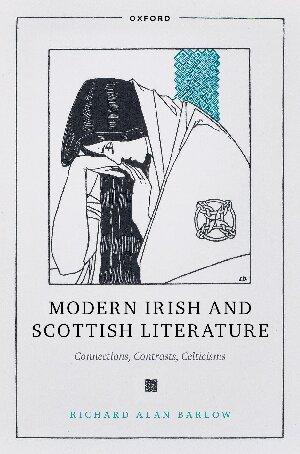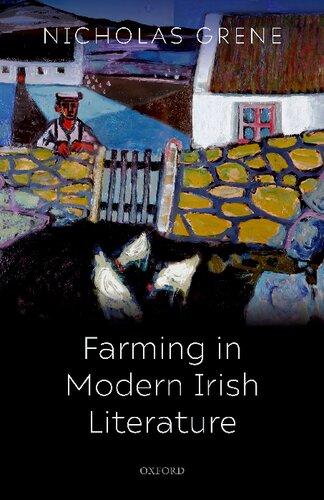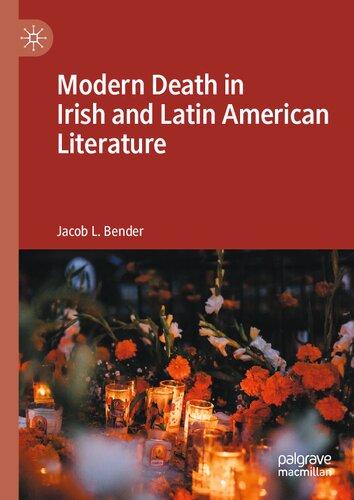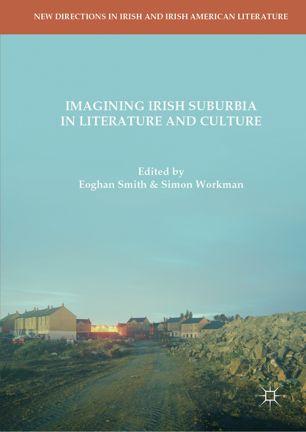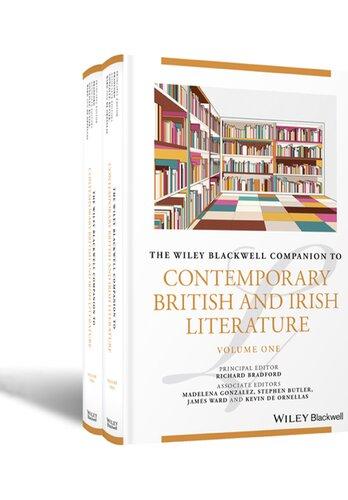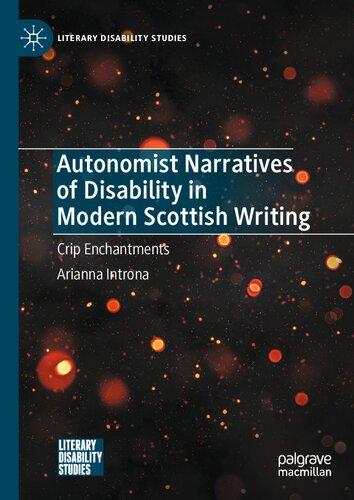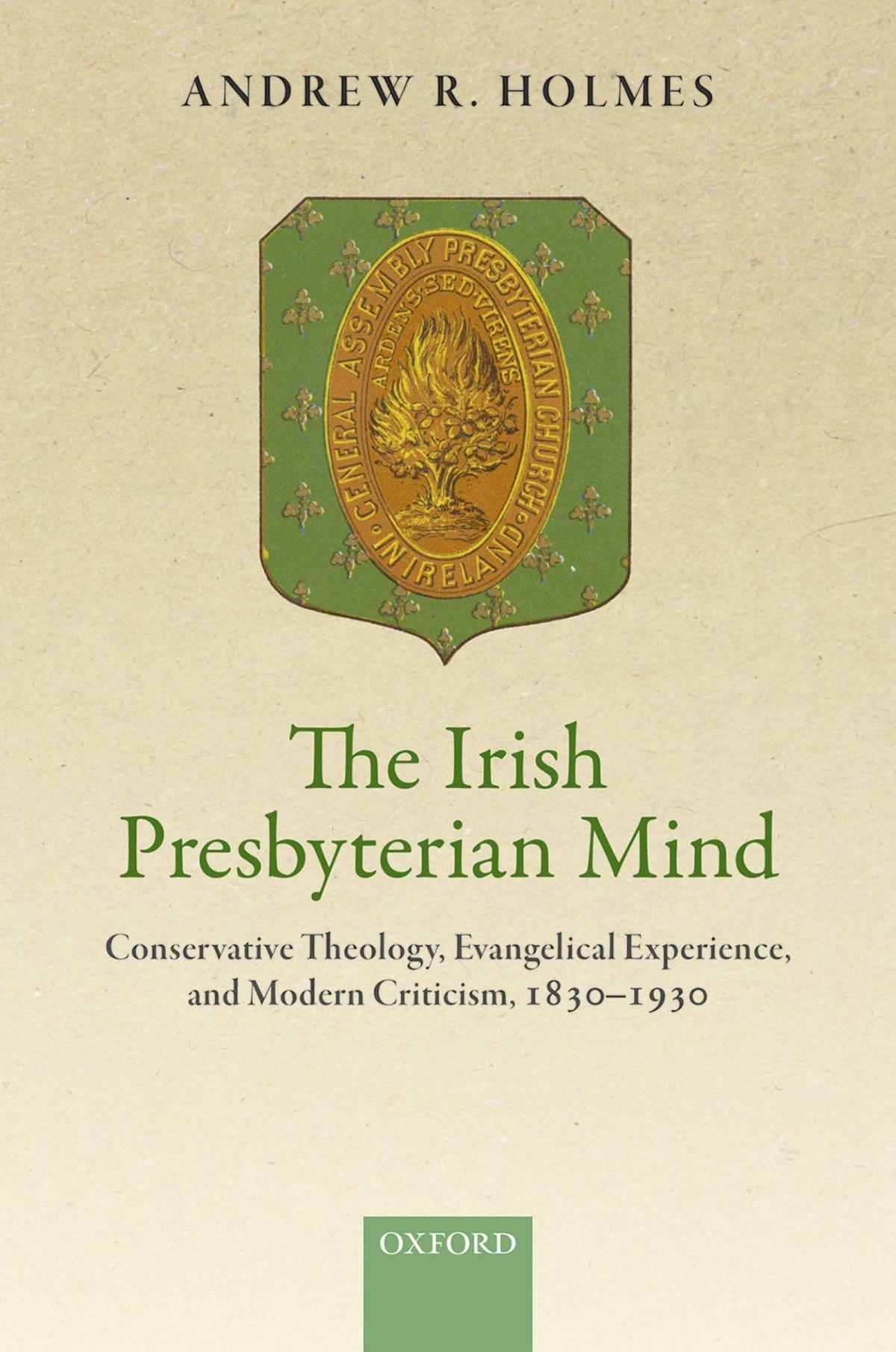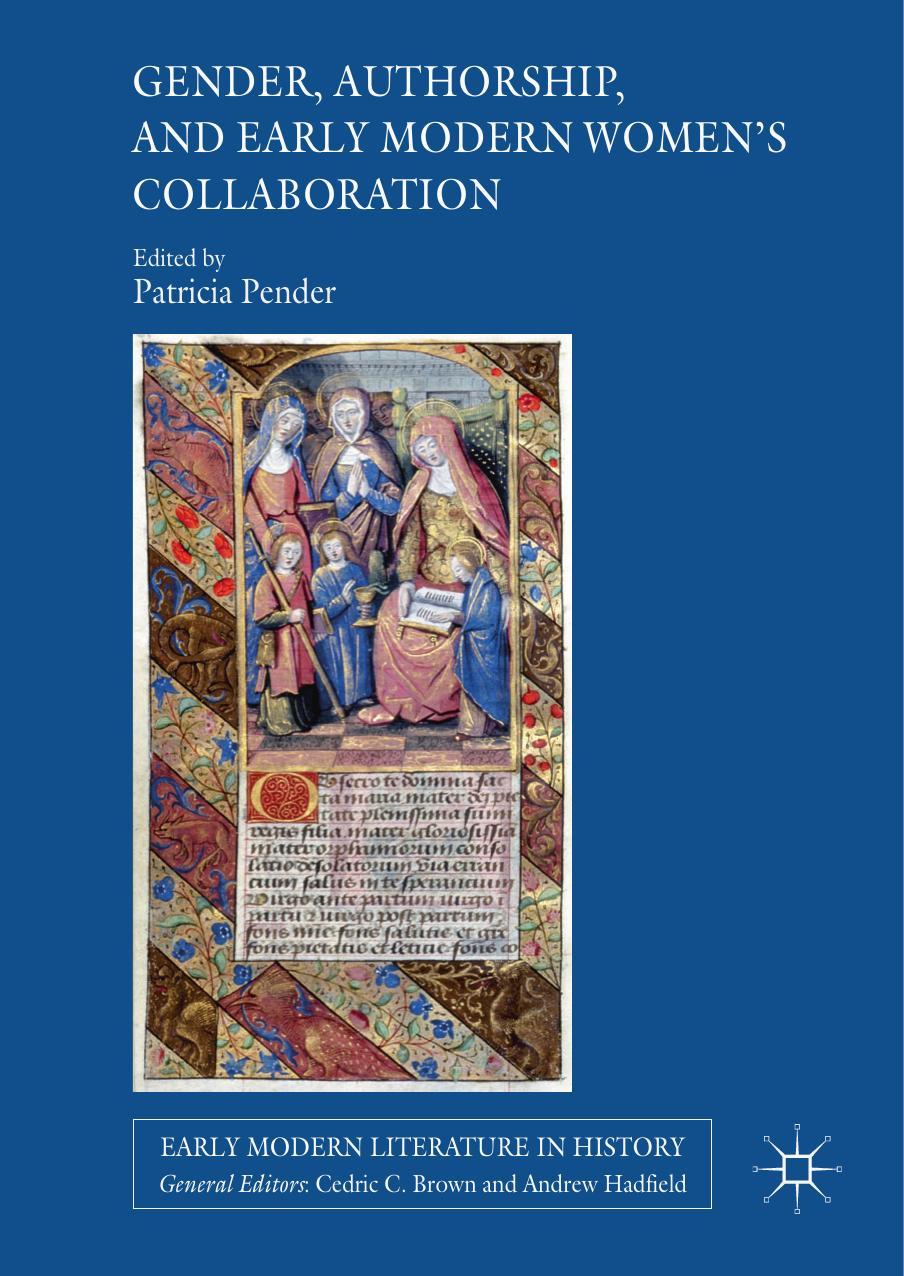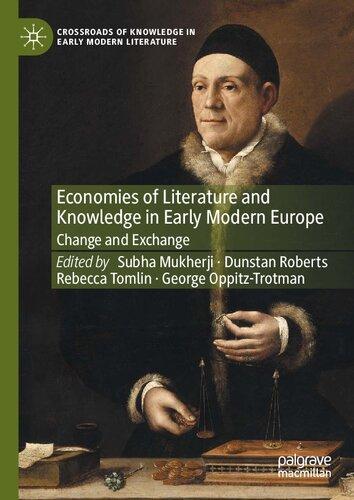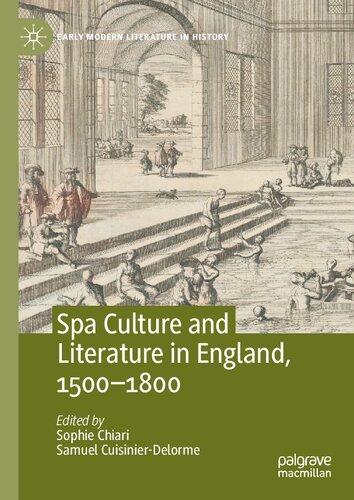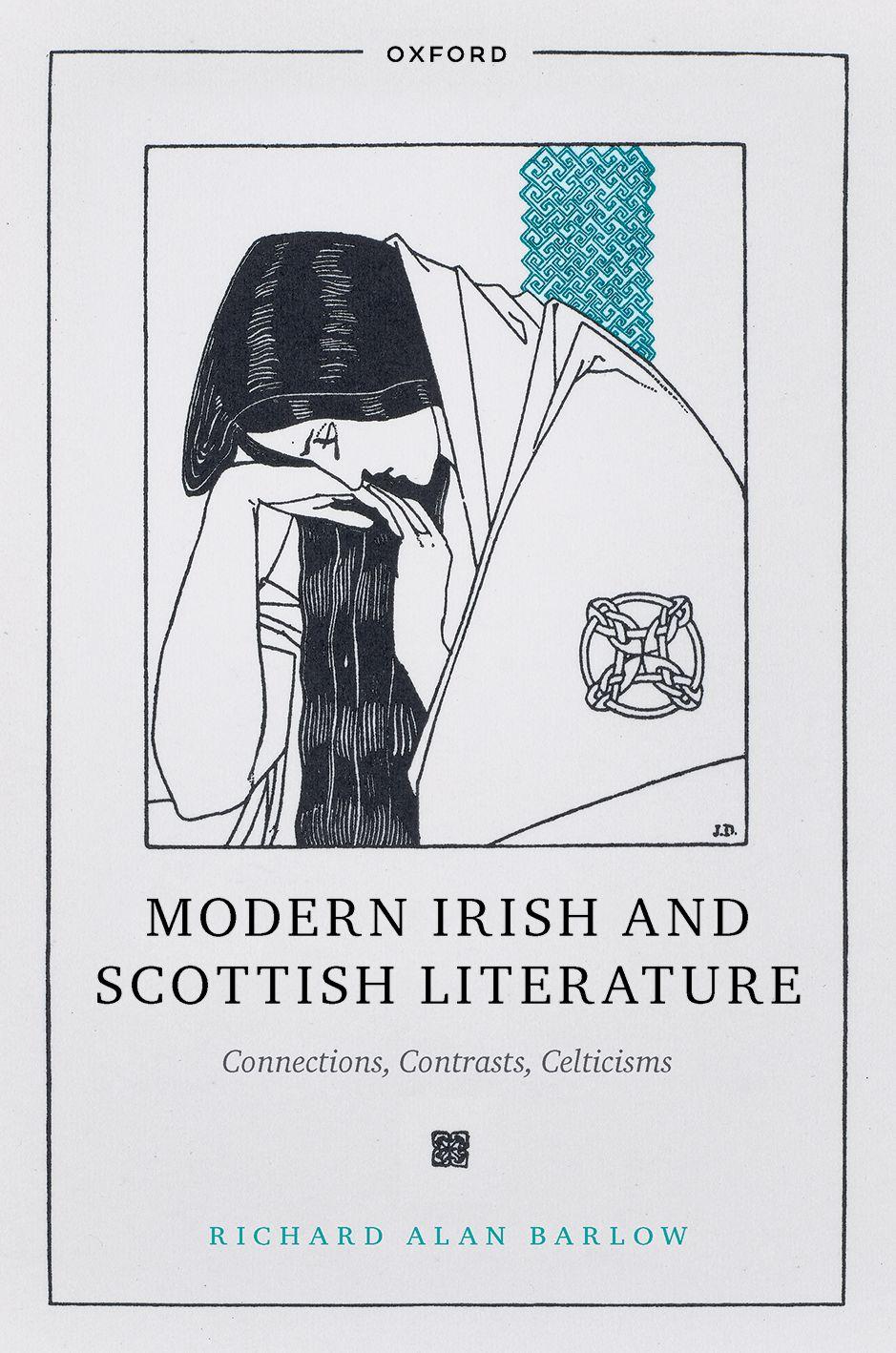Modern Irish and Scottish Literature
Connections, Contrasts, Celticisms
RICHARD ALAN BARLOW
Great Clarendon Street, Oxford, OX2 6DP, United Kingdom
Oxford University Press is a department of the University of Oxford. It furthers the University’s objective of excellence in research, scholarship, and education by publishing worldwide. Oxford is a registered trade mark of Oxford University Press in the UK and in certain other countries
© Richard Alan Barlow 2023
The moral rights of the author have been asserted
First Edition published in 2023
Impression: 1
All rights reserved. No part of this publication may be reproduced, stored in a retrieval system, or transmitted, in any form or by any means, without the prior permission in writing of Oxford University Press, or as expressly permitted by law, by licence or under terms agreed with the appropriate reprographics rights organization. Enquiries concerning reproduction outside the scope of the above should be sent to the Rights Department, Oxford University Press, at the address above
You must not circulate this work in any other form and you must impose this same condition on any acquirer
Published in the United States of America by Oxford University Press 198 Madison Avenue, New York, NY 10016, United States of America
British Library Cataloguing in Publication Data
Data available
Library of Congress Control Number: 2022939690
ISBN 978–0–19–285918–1
DOI: 10.1093/oso/9780192859181.001.0001
Printed and bound by CPI Group (UK) Ltd, Croydon, CR0 4YY
Links to third party websites are provided by Oxford in good faith and for information only. Oxford disclaims any responsibility for the materials contained in any third party website referenced in this work.
To Guinevere, Niamh, Clodagh, and Séamus
Acknowledgements
Many thanks to Jacqueline Norton, Karen Raith, Ellie Collins, Emma Varley, Rob Wilkinson, and the rest of the team at Oxford University Press for all their hard work. I would also like to thank the three anonymous scholars who read this for OUP. Taing mhòr to Kate Mathis for reading and commenting on Chapter 2. Go raibh míle maith agaibh to Anne Marie D’Arcy and Nicholas Allen for reading the manuscript at different stages and for providing valuable advice and suggestions. I would like to thank my friends and colleagues, particularly John McCourt, Willy Maley, Niall Whelehan, Shane Darcy (and the rest of the Darcy family in Limerick and Galway), Katherine Ebury, Paul Fagan, Euan Bain, Steven Archibald, Paul Fraser, Laura Pelaschiar, Michelle Witen, Maria-Daniella Dick, Ronan Crowley, Brian Caraher, Lynne and Rob Taplin, Edel Hughes, Javier Santoyo, Chris Trigg, Kate Wakely-Mulroney, Barrie Sherwood, and Tamara Radak. Thanks also to my parents Harry and Judi and my sister Lucy. Thanks to the School of Humanities at Nanyang Technological University for allowing me to take a sabbatical to finish writing this and to Ng Kai for help with the bibliography. My biggest thanks go to my wife Guinevere and my children Séamus, Clodagh, and Niamh.
An early version of Chapter 1 appeared as ‘Celticism, ballad transmission, and the schizoid voice: Ossianic fragments in Owenson, Yeats, Joyce, and Beckett’ in Irish Studies Review 27.4 (2019). A version of Chapter 3 appeared as ‘James Joyce and Walter Scott: Incest, Rivers of History, and “old useless papers” ’ in Scottish Literary Review 12.1 (2020). Part of Chapter 4 appeared in Willy Maley and Kirsty Lusk, eds., Scotland and the Easter Rising (Edinburgh: Luath Press, 2016). I am grateful to the editors of these publications for permission to reproduce these sections here.
The cover image of this book is reproduced by kind permission of the National Library of Scotland.
Thanks to the University of Strathclyde Archives and Special Collections for permission to quote from the Patrick Geddes Papers.
An excerpt from John Hewitt’s ‘To a Modern Irish Poet’ is reproduced by kind permission of The John Hewitt Society.
Extracts from Hugh MacDiarmid’s Complete Poems Vol. I are reprinted by kind permission of Carcanet Press, Manchester.
Sorley MacLean’s ‘Àrd-Mhusaeum na h-Èireann’ is reproduced with permission of Birlinn Limited through PLSclear.
Excerpt/s from FINDERS KEEPERS: SELECTED PROSE 1971–2001 by Seamus Heaney. Copyright © 2002 by Seamus Heaney. Reprinted by permission of Farrar, Straus and Giroux. All Rights Reserved.
Excerpts from OPENED GROUND: SELECTED POEMS 1966–1996 by Seamus Heaney. Copyright © 1998 by Seamus Heaney. Reprinted by permission of Farrar, Straus and Giroux. All Rights Reserved.
Excerpts from SWEENEY ASTRAY by Seamus Heaney. Copyright © 1984 by Seamus Heaney. Reprinted by permission of Farrar, Straus and Giroux. All Rights Reserved.
Excerpts from Sweeney Astray by Seamus Heaney are also reprinted by permission of Faber and Faber Ltd.
Every reasonable effort has been made to secure permissions for the quotation of literary works. The author will gladly rectify matters if anything has been inadvertently overlooked.
Gender, nationality, and Celticism in Gregory and Macleod
3. Joyce and Scott: Sex, history, and Celticism
4. Scottish Modernism and the Celtic world: MacDiarmid and MacLean
Abbreviations
CL I Yeats, W.B. The Collected Letters of W.B. Yeats Volume I: 1865–1895 edited by John Kelly. Oxford: Clarendon Press, 1986.
CL II Yeats, W.B. The Collected Letters of W.B. Yeats Volume II: 1896–1900 edited by Warwick Gould, John Kelly, and Dierdre Toomey. Oxford: Clarendon Press, 1997.
CP MacDiarmid, Hugh. Complete Poems Vol. I edited by Michael Grieve and W.R. Aitken. Manchester: Carcanet, 2017.
D Joyce, James. Dubliners. New York: Viking Press, 1967.
FK Heaney, Seamus. Finders Keepers: Selected Prose, 1971–2001. London: Faber and Faber, 2002.
FW Joyce, James. Finnegans Wake. New York: Viking Press, 1939. Citations for Finnegans Wake are made in the standard fashion, i.e. page number followed by line number.
IMJJ MacDiarmid, Hugh. In Memoriam James Joyce: A Vision of World Language. Glasgow: William Maclellan, 1955.
JJ Ellmann, Richard. James Joyce. Rev. ed. New York: Oxford University Press, 1982.
OCPW Joyce, James. Occasional, Critical, and Political Writings, edited by Kevin Barry. Oxford: Oxford University Press, 2000.
P Joyce, James. A Portrait of the Artist as a Young Man. New York: The Viking Press, 1964.
RT I MacDiarmid, Hugh. The Raucle Tongue: Hitherto Uncollected Prose Vol. I edited by Angus Calder, Glen Murray, and Alan Riach. Manchester: Carcanet, 1996.
RT II MacDiarmid, Hugh. The Raucle Tongue: Hitherto Uncollected Prose Vol. II edited by Angus Calder, Glen Murray, and Alan Riach. Manchester: Carcanet, 1997.
RT III MacDiarmid, Hugh. The Raucle Tongue: Hitherto Uncollected Prose Vol. III edited by Angus Calder, Glen Murray, and Alan Riach. Manchester: Carcanet, 1998.
SA Heaney, Seamus. Sweeney Astray: A Version from the Irish. Derry: Field Day, 1983.
U Joyce, James. Ulysses. The corrected text, edited by Hans Walter Gabler. New York: Random House, 1986. Citations for Ulysses are made in the usual way: episode number followed by line number.
Introduction
Ireland, Scotland, and Celticism
In The Trembling of the Veil (1922), W.B. Yeats tells of his encounters with the occultist and self-styled Scotsman Samuel Liddell MacGregor Mathers.1 Aside from his apparent gifts for prophecy and clairvoyance, Mathers was also an enthusiast for Scottish Highland culture, or certain visions of it. Mathers seems to have been a slightly prickly individual and on one occasion Yeats drew his ire by doubting the authenticity of James Macpherson’s Ossian poems:
Once when I questioned [the authenticity of] Ossian, he got into a rage— what right had I to take sides with the English enemy?—and I found that for him the eighteenth-century controversy still raged. At night he would dress himself in Highland dress, and dance the sword dance, and his mind brooded upon the ramifications of clans and tartans. Yet I have at moments doubted whether he had seen the Highlands. . . .2
Macpherson’s Ossian, the subject of the disagreement between the two men, is the basis of literary Celticism. Ossian is also a hugely important set of texts in the overall development of Irish and Scottish literature. The publication of Macpherson’s Ossian, beginning with Fragments of Ancient Poetry, Collected in the Highlands of Scotland, and Translated from the Galic or Erse Language in 1760, was a pivotal event in the development of the English-language literatures of Scotland and Ireland. In addition to being the work that
1 Mathers, a founder member of the Hermetic Order of the Golden Dawn, was from London and was assigned the name Samuel Liddell at birth. However, he identified as Scottish and claimed, perhaps spuriously, Highland ancestry. According to Foster, Yeats ‘probably met Mathers in the Reading Room of the British Library after 1887’ (Foster, Yeats I, 104). Yeats and Mathers met on a number of occasions in Paris in the mid-1890s. It is not clear from The Trembling of the Veil when exactly the meeting described above took place, but it was probably in February 1894. See Finneran, 543.
2 Yeats, Collected Works III, 257. The terms ‘Ossian’ and ‘Macpherson’s Ossian’ are used here to denote the totality of Macpherson’s Ossianic output, including Fragments of Ancient Poetry, Collected in the Highlands of Scotland and Translated from the Galic or Erse Language (1760); Fingal, an Ancient Epic Poem in Six Books, together with Several Other Poems composed by Ossian, the Son of Fingal, translated from the Galic Language (1761); and Temora (1763).
Modern Irish and Scottish Literature: Connections, Contrasts, Celticisms. Richard Alan Barlow, Oxford University Press. © Richard Alan Barlow 2023. DOI: 10.1093/oso/9780192859181.003.0001
introduced the tone of Romanticism,3 Macpherson’s poems inspired and influenced countless Irish and Scottish texts over the following centuries (including works that were written as a reaction against them). While the Ossian controversy had largely died down by the nineteenth century— Mathers notwithstanding—literary Celticism has had a very long and varied existence. Mutated forms of Celticism survived beyond the era of Yeats and Mathers and well into the twentieth century. Varieties of Celticism also attracted key figures of nineteenth- and twentieth-century Irish and Scottish culture such as Sydney Owenson, Walter Scott, Augusta Gregory, Fiona Macleod, James Joyce, Hugh MacDiarmid, and Seamus Heaney. This book traces Irish and Scottish literary engagements with Celticism, from the era of Romanticism, through the Celtic Revival(s) and the Irish and Scottish Revivals more broadly,4 within Modernism, and into the contemporary era. An analysis of Irish and Scottish Celticisms is carried out here as part of a comparative study of the modern literatures of Ireland and Scotland.
Since Macpherson’s Ossian poems can be thought of as ‘belonging’ to both Ireland and Scotland (as Scottish texts but largely based on originally Irish stories), and since they also initiated literary Celticism, it makes sense to think about the development of writing in both countries during the modern period in relation to the central theme of the Celtic, while also considering the processes in which the literature of Scotland has influenced Irish writing and vice versa. This text offers such an examination, within the context of the relatively new field of Irish-Scottish studies. This discipline has developed in recent decades, especially after Scottish devolution and the peace process in the north of Ireland,5 alongside a devolved approach to the history and culture of the Atlantic archipelago and a movement away from Anglocentrism within historical and cultural studies. The work of historian J.G.A. Pocock, especially his text The Discovery of Islands, has been central to this new approach.
In The Discovery of Islands, Pocock suggests that ‘British history’ ‘has in the past denoted nothing much more than “English history” with occasional transitory additions’,6 adding that ‘there was, and still is, no “British history” in the sense of the self-authenticated history of a self-perpetuating polity or
3 See Crawford, ‘Post-Cullodenism’, 18, Mercier, 230, and Stafford, ‘Romantic’, 27.
4 NB: This text refers to the Celtic Revivals of Ireland and Scotland (and hence uses the terms ‘Irish Celtic Revival’ and ‘Scottish Celtic Revival’ to differentiate between these two phenomena) as well as to the broader cultural revivals of the two nations (i.e. the Irish Revival and the Scottish Revival, with the latter including the ‘Scottish Literary Renaissance’). In both Ireland and Scotland, a Celtic-focused revival formed an initial stage of a larger cultural revival.
5 See Longley, 8. 6 Pocock, 77.
culture. The term must be used to denote a multiplicity of histories, written by or (more probably) written about a multiplicity of kingdoms and other provinces.’7 Part of Pocock’s multiplicity of histories is his awareness of a ‘Celtic, oceanic and extra-European world’ to the west of England during the period of the consolidation of the Scottish kingdom.8 Within this Celtic world, there are particularly strong similarities between Scotland and Ireland, in the present day as in the ancient past. As Ray Ryan has noted,
Scotland and Ireland both have a Gaelic and English linguistic tradition (with Scots a third dimension in Scotland), a Catholic and Protestant sectarian conflict, urbanized centres, and benighted rural hinterlands; and linked to this last point, the creation of a mystique of Irishness and Scottishness traceable to these depopulated zones. In both countries, an Act of Union with the British state still remains contested.9
Following the Roman era of European history, important links between Ireland and Scotland continued to develop in the Medieval period. As Murray Pittock reminds us, ‘until at least the twelfth century, “Scotus” was a term indicative of either Scots or Irish nationality’.10 The formation of the Scottish nation began with the crossing of an Irish group known to the Romans as the ‘Scoti’ and their gradual amalgamation with the indigenous Picts. During the Middle Ages, areas of Ireland and Scotland spoke closely related languages (Scottish Gaelic developed out of Old Irish and both are part of the Q-Celtic or Goidelic group of Celtic languages) and shared what we now refer to as early Irish literature, including the Fenian and Ulster Cycles. According to Edna Longley, ‘during the high bardic period (c. 1200–1600), literary
7 Ibid., 75.
8 Ibid., 31. This Celtic world is ‘extra-European’ since the Roman empire did not ‘effectively penetrate to all the oceanic or Atlantic regions of the archipelago, and the second-largest island [was] not directly affected by Roman government’ (Ibid., 30).
9 Ryan, 10. See also: ‘Even on the most superficial examination, it [is] clear that both countries have been profoundly affected by a similar geography, by a Celtic heritage, and by a history of close political and economic links with England’ (Cullen and Smout, v). However, as Ryan notes, the Republic of Ireland is ‘a state that does not correspond with the historically defined nation’ while Scotland is currently a ‘stateless nation’ (Ryan, 12).
10 Pittock, Celtic Identity, 15. See also: ‘in 1004 the Irish hero Brian Boru was described as “imperator Scotorum”. The Scots repaid this compliment by deriving their royal line from Irish roots: the Scottish crown’s descent from Irish kings, though less emphasized as the Middle Ages progressed, was an important indicator of difference from England and Wales, and indeed betokened a continuing consciousness of cultural alliance with Ireland: the Scottish kingdom was born of Irish immigration. When Bruce appealed to Irish leaders as representatives of “our common people”, “nostro nacio”, he was simply recognizing the continuing political and cultural significance of this fact’ (Pittock, Celtic Identity, 15).
connection was constant: a “supra-national” learned class shared a common literary language and trained in the same schools. By the same token, the collapse of the Irish bardic order “deeply splintered” the Gaelic world.’11 In the early modern period, Irish troops served in Scottish armies, powerful families held land in both countries, and large numbers of Irish students attended university at Glasgow and Edinburgh.12 Later, the plantation of Lowland Scots (and English people) into the north of Ireland in the seventeenth century created what Pocock has called a ‘settler nation’ and an ‘anti-nation’ within Ireland.13 In the post-Famine period, large-scale emigration went in the opposite direction, with Irish labourers seeking work in industrial centres such as Glasgow. As R.F. Foster has noted, ‘By 1851, 6.7 per cent of the entire Scottish population was Irish-born, a percentage that rose to over 18 per cent in Dundee and Glasgow’.14 In addition to mass emigration from Ireland, the Great Famine of 1845 to 1852 caused a steep decline in the Irish language. Gaelic faced similar deterioration in the Highlands and Islands of Scotland, especially after the clearances of the eighteenth and nineteenth centuries. Given the close historical and cultural links between Ireland and Scotland, it is unsurprising that the literatures of the two nations should be intertwined. As Ryan notes, Ireland and Scotland ‘share an oppressive relation to the English literary tradition which was at least partly responsible for the ideological conviction held by Pearse and Yeats, MacDiarmid and Scott, that a community existed that had to be recovered and restored’.15 Irish-Scottish literary connections have been studied in texts such as Ryan’s Ireland and Scotland: Literature and Culture, State and Nation, 1966–2000 (2002), McIlvanney and Ryan’s edited collection Ireland and Scotland: Culture and Society, 1700-2000 (2005), Murray Pittock’s Scottish and Irish Romanticism (2008), and Peter Mackay, Edna Longley, and Fran Brearton’s volume Modern Irish and Scottish Poetry (2011). As McIlvanney and Ryan comment in the introduction to their text,
Scotland – subject to so many of the same linguistic, religious, political and cultural pressures as Ireland, caught up in its own obsessive engagement with England and Britain, and marked both by a breach with its Gaelic past and a philosophical and economic modernization around
11 Longley, 10.
12 See Pittock, Scottish and Irish Romanticism, 15 and Trumpener, ‘Ireland, Scotland, and the politics of form’, 166.
13 Pocock, 33. 14 Foster, Modern Ireland, 368.
15 Ryan, 10.
metropolitan markets – provides a compelling comparative context for Irish culture and society.16
The literary links explored in the aforementioned texts, and in Irish-Scottish studies more broadly, are too numerous to be mentioned extensively here. However, some of the most important are the relationship between the traditional cultures of the Irish and Scottish Gaelic languages (the shared Fenian stories, for example),17 the connections between Irish and Scottish Jacobite poetry, the influence of Maria Edgeworth’s regional novels on Walter Scott’s historical fiction and national tales, Robert Burns’ reception in the north of Ireland, Thomas Carlyle’s impact on the development of the Irish Revival, and James Joyce’s interest in Scottish history, literature, and philosophy. One of the most important and long-standing interfaces between the literary cultures of Ireland and Scotland is the discourse of Celticism. Since this discourse is important to both literary traditions, this book will study modern Irish and Scottish literature within the context of Celticism.
Within the Atlantic archipelago, there is a persistent idea that Ireland, Scotland, and Wales are qualitatively different to England, that they are inherently and permanently ‘Celtic’ in spite of modern realities, and that nations of the ‘Celtic Fringe’ (a term which places England at the centre and places the ‘Celtic nations’ at the periphery) share some vague spiritual or racial bond.18 As Barry Cunliffe writes in The Ancient Celts, ‘The Celt as “other” living in the wild extremities of Atlantic Europe is a metaphor still very much alive today’.19 The use of this term as a way to draw Ireland, Scotland, and Wales together happens despite a lack of evidence to suggest a racial link between the modern ‘Celtic nations’. Furthermore, no modern nation could be considered purely or predominantly Celtic in terms of everyday language, let alone
16 McIlvanney and Ryan, 13.
17 Fenian literature is ‘a versatile and long-lived tradition manifesting in a number of forms over the centuries, from medieval and early modern prose-sagas and poetry down to oral material collected in Ireland and Gaelic Scotland over the last two hundred years’ Williams, Mark, 199).
18 Of the nations of the ‘Celtic Fringe’ of the Atlantic archipelago, this book focuses on Ireland and Scotland in order to follow the development of a series of literary exchanges and connections that begins with the publication of Macpherson’s Ossian. Also, many of the texts studied here—or sections of those texts—focus specifically on Irish-Scottish links (such as Sydney Owenson’s The Wild Irish Girl, Hugh MacDiarmid’s To Circumjack Cencrastus and In Memoriam James Joyce, Seamus Heaney’s Sweeney Astray and ‘Sweeney Redivivus’) or were produced within a loose network of Irish and Scottish writers (such as the texts of Augusta Gregory and Fiona Macleod). Some of these texts include references to Wales (such as In Memoriam James Joyce) but these are not as obviously foregrounded in the way that Irish-Scottish connections are.
19 Cunliffe, 22. Indeed, claims to Celtic ethnicity and identity also occur beyond Atlantic Europe in places like Italy and the USA and have, in recent years, been linked to far-right politics. See Hague et al.
through what James Joyce called ‘Celtic blood’.20 Indeed, there was never a single European ‘Celtic’ race even in ancient times. The notion that Ireland, Scotland, and Wales are essentially Celtic, and that they are part of a racial family, has strong connections with the supranational culture of Celticism, ‘a multi-genre, multinational phenomenon’ which dates back to the eighteenth century.21 George Watson has defined Celticism is an ‘ideological construction’ and ‘an attempt to create, re-create or assert a cultural identity for the people of Ireland, Scotland and Wales which will distinguish them from the majority inhabitants of the British Isles [sic], the English’.22 Celticism ‘may be generated internally; or imposed from the centre externally, as may be seen to this day in the common and contentious designation of these three nations as “the Celtic Fringe” ’.23
In the ancient world, the first reference to the Celts appears in the work of the Greek geographer Hecataeus of Miletus in the sixth century bce .24 In the fourth and third centuries bce ,
the Celtic stereotype was to acquire its familiar form. They were unrestrained, fearless warriors, irrationally brave in the first onslaught but prone to wild despair if the battle turned against them. Unpredictable and unreliable as allies, they could easily be aroused to battle fury but could quickly become too drunk or too paralysed by superstitious fear to fight. And above all they were barbarians: people of alien behaviour, cruel, and prone to such savagery as human sacrifice and even cannibalism.25
In the later work of Poseidonius, a slightly different picture emerges. As Cunliffe has noted, in Poseidonius’ Histories the Celts were warlike and ‘impetuous’ but they also lived under the wise rule of the Druids who acted as philosophers and men of science.26 The term ‘Celt’ has also been used as a blanket term to cover tribes such as the Gauls and Britons mentioned in Roman documents.27 Eventually the Celts disappear—for a time—from
20 OCPW, 115. ‘In March 2015, an article titled “The Fine-Scale Genetic Structure of the British Population” [showed that] there was no common genetic link between the supposed Celtic peoples of Britain and Ireland’ (De Barra, 13).
21 Leerssen, ‘Celticism’, 20. 22 Watson, George, ‘Aspects’, 129. 23 Ibid., 129.
24 See Cunliffe, 2. 25 Cunliffe, 6. 26 Ibid., 11.
27 See Leerseen, 1. On the subject of the word ‘Celt’, Cunliffe observes that ‘Classical observers refer to the Continental Celts by a variety of names. The Roman historians writing of the migrations from north of the Alps to the Po valley and beyond called them Galli, and this tradition was followed by Polybius, to whom they were Galatae, a name also commonly used in other Greek sources. Most of the first-century BC writers, however, realized that these names were interchangeable with the Greek Keltoi and Latin Celtae’ (Cunliffe, 3). However, Rachel Pope has argued that ‘Archaeologists trained in the 1960s and 1970s [generalized]. Instead of working to understand texts historically/
history. There is a period from the fourth century until the sixteenth century when
the world cared little for Celts. The classical texts were largely lost or forgotten, and the universal appeal of Christianity, with its own texts, mythologies, and stereotypes, provided all the models that were required to order behaviour and to inspire origin myths and protohistories. Yet it was Christianity that kept alive a knowledge of the Celts in the manuscript copies of the classical sources preserved in monastic libraries. In the sixteenth century many of these texts began to become more widely available in printed form By the beginning of the eighteenth century the antiquarians concerned with early Europe had access to the principal classical texts, a varied array of ethnological analogies, and a growing knowledge of the prehistoric monuments and artefacts of their own countries.28
Perhaps the most important sixteenth-century scholar of Celtic languages was the Scottish historian George Buchanan. According to Eoin MacNeill, Buchanan was ‘the pioneer in Celtic philology’ and ‘the first in modern times who recognised that the Irish, the Scots and the Britons were nations of Celtic origin’.29
Within linguistics, the use of the terms ‘Celt’ and ‘Celtic’ was firmly established in eighteenth-century works of comparative philology such as PaulYves Pezron’s Antiquité de la nation et de la langue des Celtes autrement appelez Gaulois (1703, translated into English in 1706 as Antiquities of nations, more particularly of the Celtae or Gauls, Taken to be originally the same people as our ancient Britons) and Edward Lhuyd’s Archaeologia Britannica (1707).30
Beginning with these texts, a field developed that categorized modern languages spoken in parts of the Atlantic archipelago (that ‘Celtic, oceanic and extra-European world’ mentioned by Pocock) such as Irish, Scottish Gaelic, and Welsh as part of the same linguistic family, along with Breton and some
contextually . . . references to Keltoi, Celtae, Galatai, Galatae, and Galli were all simply conflated. This was the generalizing method of d’Arbois de Jubainville’ adding that ‘while 20th century archaeologists (Déchelette, Kruta, Cunliffe) used “Celts” as a generic term for Iron Age Europe, this was not the case among early Mediterranean writers’ (Pope, 16, 32). For Pope, ‘The name “Celt” was, and remains, a categorization by Greeks, Romans, and archaeologists for various small-scale Early Iron Age groups’ (Pope, 57).
28 Cunliffe, 14–15. 29 MacNeill, ‘Re-Discovery’, 522.
30 According to Leerssen, Pezron’s text ‘seems to have brought the notion “Celt” as an umbrella term for ancient Gauls and modern Cymri/Bretons into general use; at the same time, Edward Lhuyd demonstrated the Celtic co-familiarity between Cymri and Gaels in his Archaeologia Britannica’ (Leerssen, ‘Celticism’, 5).
extinct European languages. It should be noted that the ancient peoples now thought of as Celtic did not refer to themselves as Celts (something that was pointed out by prominent figures following the late nineteenth/early twentieth-century Irish Revival).31
The origins of Celticism itself are to be found later in the eighteenth century, in the work of the Scottish Highlander James Macpherson.32 Macpherson claimed to have discovered lost ancient epic poetry of Scotland by the bardic figure Ossian (Oisín). Products of post-Culloden Scotland, Macpherson’s English language ‘translations’—Fragments of Ancient Poetry (1760), Fingal (1761), and Temora (1763)—sparked a Celticist craze across Europe and had a massive influence on European culture and scholarship.33 However, Macpherson never produced his source texts and his work is now often regarded as a hoax, a forgery, or as a form of literary fraud. This assessment is unfair to an extent, since Macpherson did work with traditional sources.34 Macpherson carried out fieldwork in the Highlands and Islands of Scotland in 1760 and 1761, searching for oral and textual examples of ancient Gaelic poetry and gathering together a valuable manuscript collection.35 However, Macpherson reworked and embellished his source material, making it accessible and palatable for a late eighteenth-century Anglophone audience and adapting it to suit the age of sentiment.36 As is discussed in Chapter 1, Irish authors and scholars were simultaneously offended by Macpherson’s activities and creatively stimulated by them. Furthermore, the scholarly activity that arose in the years following Macpherson’s Ossian, by figures such as Sylvester
31 For example, see Eoin MacNeill’s comments in his 1919 text Phases of Irish History: ‘The term Celtic is indicative of language, not of race. We give the name Celtic to the Irish and the Britons because we know that the ancient language of each people is a Celtic language. A certain amount of enthusiasm, culminating in what is called Pan-Celticism, has gathered around the recognition of this fact that the Irish, the Gaels of Scotland, the Welsh and the Bretons are Celtic peoples . . . There is no small amount of pride in the notion of being Celtic. It is somewhat remarkable, then, to find that throughout all their early history and tradition the Irish and the Britons alike show not the slightest atom of recognition that they were Celtic peoples’ (MacNeill, Irish History, 3–4).
32 Though they are the most influential texts of early Celticism, they are predated by Thomas Gray’s Welsh-themed The Bard. A Pindaric Ode from 1757 and Macpherson’s own The Highlander from 1758.
33 For an overview of the huge influence of Ossian on European culture, see Porter, ‘Bring Me the Head of James Macpherson’, 396–7.
34 ‘Although the relationship between The Poems of Ossian and traditional Gaelic verse has been the subject of major scholarly investigations since the 1760s, and it has long been established that Macpherson drew on traditional sources to produce imaginative texts not modelled closely on any single identifiable original, the idea that he was the author of an elaborate hoax persists’ (Stafford, ‘Introduction’, vii).
35 ‘Macpherson had in his travels gathered together an important collection of manuscripts which, but for his intervention, might have been entirely lost. Important among them were the early sixteenth-century work now known as The Book of the Dean of Lismore, An Leabhar Dearg and An Duanaire Ruadh’ (Chapman, 39).
36 See Pittock, Celtic Identity, 35.
O’Halloran, laid some of the foundations for the Irish Revival of the late nineteenth/early twentieth century.
Despite the rage for all things Celtic that spread across Europe in the wake of Macpherson’s Ossian, there was also a strong current of anti-Celtic sentiment in the long eighteenth century, even in the Celtic nations themselves (sometimes involving a fierce reaction against Macpherson’s work). This was related to a political discourse in which the population of the archipelago was neatly divided into Celtic and Germanic (or Gothic) components, with Celts imagined to be the racially inferior group. One of the leading figure of this discourse was the notoriously racist Scottish antiquarian John Pinkerton. For Pinkerton, modern Celts were
mere radical savages, not yet advanced even to a state of barbarism; and if any foreigner doubts this, he has only to step into the Celtic part of Wales, Ireland, or Scotland, and look at them, for they are just as they were, incapable of industry or civilization, even after half their blood is Gothic, and remain, as marked by the ancients, fond of lyes, and enemies of truth.37
Within Scotland, according to Pinkerton, the Gothic/Germanic Lowlanders were ‘acute, industrious, sensible, erect, free’ while the Celtic Highlanders were ‘indolent, slavish’ and ‘strangers to industry’.38 As Silke Stroh has shown, anti-Celtic bias in Scotland was linked to anxieties concerning the condition of British rule in Ireland. Furthermore, the
Gaelic, and thus part-Irish, element in Scottish history had to be played down. To admit that Scotland had developed from a ‘Dark Age’ Irish colonial movement would have meant an uncanny reversal of these regions’ modern roles, where Scotland was not only a globally imperialist junior partner but had also played a key role in colonizing Ulster.39
Negative attitudes in Scotland towards the Gaelic language increased markedly during this period.40
37 Pinkerton, Dissertation, 69.
38 Pinkerton, Enquiry, 339. As Michael Shaw has observed, ‘various Scottish Enlightenment figures attempted to highlight the supposed Germanic ethnicity of the Scottish Lowlands as a means of integrating Scotland into the English “economic and imperialist core” and distancing themselves from dissenting Jacobites’ (Shaw, 39).
39 Stroh, 195.
40 According to Murray Pittock, ‘antipathy to Gaelic Scotland had been around since the fifteenth century and had been deepened by the Reformation; but the eighteenth century moved it on to the level of theory’ (Pittock, Scottish and Irish Romanticism, 69).
In the nineteenth century, within the work of Matthew Arnold and Ernest Renan, an influential theory developed in which the Saxon and the Celt (i.e. the English and the non-English inhabitants of the Atlantic archipelago, respectively) were diametrically opposed in terms of their essential qualities:
Renan’s Celt . . . takes much of his shape in opposition to rationality, intellectuality, and a materialist world of scientific and political manipulation. Instead of these the Celt has an artistic capacity beyond the ordinary, a religious instinct of unusual depth, a strength and profundity of thought and feeling but a weakness in the external world of action, a ready emotionality and an easy communion with nature, a strength in domesticity but a weakness in a wider political sphere, and a femininity . . . Passion, irrationality, obscure consciousness, sensitiveness, affection and nature are opposed to and thus defined by contrast to intellectuality, reasonings, hard scholasticism, merciless dissection and science. The opposition of the Celt to the qualities ascribed to science is made more explicitly by Arnold. . . .41
In many of the texts covered in this study, Celtic nature forms one half of a binary structure—it exists against either modernity, Christianity, the ‘centre’, the Anglo-Saxon world, or Englishness (or the English core as modernity), or it is associated with one gender as opposed to another. However, all of the above can be complicated by a number of factors—Celticism is an essentially modern phenomenon, many of its writers were committed Christians, our knowledge of pre-Christian beliefs in Ireland is derived mainly from monastic scriptoria, some the most important branches of Celticism developed in London, and one of its major proponents was a man writing as a woman.
Developing Renan’s work, Matthew Arnold wished to find a perfect synthesis of the ‘lively’ Celt and the ‘prosaic, practical Saxon’, and called for a ‘fusion of all the inhabitants of these islands into one homogenous, English-speaking whole’.
42 As Leith Davis has noted, Arnold wanted to
41 Chapman, 86–7. There are important connections between the development of Celticism and that of Orientalism. As Joseph Lennon has noted: ‘Orientalism in Ireland undeniably influenced the coemergence of Celticism, and vice versa’ (Lennon, 62). See also: ‘Edward Said’s statement of the relations of power inscribed in the discourse of Orientalism are equally applicable to Celticism: ‘Orientalism [Celticism] depends for its strategy on flexible positional superiority, which puts the Westerner [Englishman] in a whole series of possible relationships with the Orient [Ireland] without ever losing him the upper hand’ (Cairns and Richards, 47–8).
42 Arnold, 9, 11, 12. For Arnold, an interest in Celtic languages did not equate to a desire to see those languages flourish. Arnold called for the establishment of a chair of Celtic at Oxford while also commenting that ‘the sooner the Welsh language disappears as an instrument of the practical, political, social life of Wales, the better’ (Arnold, 12).
reduce Celtic languages down into ‘products that would be consumed within the English university system’.43 In Arnold’s Celtic/Saxon binary, the Celt is feminine, spiritual, and imaginative but is useless at politics44 while the Saxon is the rational and scientific masculine master of the material world, but is lacking in soul. So, the partnership of these two races complements and completes both, with obvious political-ideological implications. In On the Study of Celtic Literature (1866)
Celticism is deployed for assimilative purposes: its subtext is how to bring Ireland more firmly into the Union. Arnold, who knew very little about the philology of the Celtic languages, and not very much even about their literary history . . . nevertheless presents a sympathetic, even attractive picture of the Celt, as spiritual, melancholy, natural and poetic. The contrast is with the materialist, philistine, utilitarian, excessively rational, artificial, industrialized and urbanized Saxon . . . Not only is the Celt impractical, he has a fatal ‘readiness to revolt against the despotism of fact’ . . . So, Arnold’s repressive tolerance suggests that the Celt is lucky to have the dull and muddy-mettled Saxon to run his affairs for him; in return the Celt will serve to leaven the Saxon lump, bringing with him to the heavy imperial dining table his wit and his visionary and spiritual qualities.45
Arnold’s work has a clear colonial and imperialist mentality. As David Lloyd has pointed out, Arnold ‘subordinates a colonized people’s culture and literature to the major canon by stereotyping the essential identity of the race concerned’.46 Arnold’s On The Study of Celtic Literature
identified the ‘Celtic Irish’ in traditionally racist terms as ‘undisciplinable, anarchical and turbulent by nature,’ ‘ineffectual in politics’ and ‘poor, slovenly and half barbarous,’ but also detected an eloquence and delicacy in Celtic literature indicative of an ardent aspiration ‘after life, light and emotion, to be expansive, adventurous and gay.’ According to Arnold, this instinct for ‘spontaneity’ and ‘imagination’ stood in stark contrast to the materialism of Victorian England. . . . 47
43 Davis, 176.
44 For Arnold, ‘the skilful and resolute appliance of means to ends which is needed to make progress in material civilization, and also to form powerful states, is just what the Celt has least turn for’ (Arnold, 105).
45 Watson, George, ‘Aspects’, 136.
46 Lloyd, Nationalism and Minor Literature, 6.
47 Platt, Joyce, Race, and Finnegans Wake, 43.
Arnold’s work (and therefore Macpherson’s work, which influenced Arnold) is also an important background to the Irish and Scottish Revivals.48
A crucial feature in Arnold’s presentation of the Celts is that they are an essentially feminine race.49 Arnold states that ‘the Celt is . . . particularly disposed to feel the spell of the feminine idiosyncrasy’.50 Similarly, Renan wrote in 1859 that ‘If it be permitted to assign sex to nations as to individuals, we should have to say without hesitance that the Celtic race, especially with regard to its Cymric or Breton branch, is an essentially feminine race’.51 A reaction against this idea is part of the more scientific, text-based scholarship of the late-nineteenth century, especially by ‘Celtologist’ scholars such as Marie Henri d’Arbois de Jubainville, Whitley Stokes, Henri Gaidoz, Ernst Windisch, Kuno Meyer, and in the pages of the Revue Celtique, founded in 1870.52 For Sínead Garrigan Mattar, the most important feature of the Revue’s approach ‘was the fastidiousness of its criticism: rigorous attention to textual detail and historical contextualization of all texts and etymologies were deemed essential if Celticism was to redefine itself as a scientific discipline’.53 This new scientific Celticism developed in line with anthropological research into the cultures of ‘primitive’ peoples.54 Research into Irish culture continued during the nineteenth century, a process that would reach a culmination at the end of the century—and the beginning of the following century—with the Irish Revival. A key early figure in this process was the Protestant barrister and antiquarian Samuel Ferguson, whose texts—such as Congal (1872)—were part of a Unionist cultural programme in which Ireland’s culture is presented as being equal in value to England’s.55 However, there were also nationalist roots to the Revival, such as the United Irishmen movement and the Young Ireland movement.56 In addition to scholarly and political developments, archaeological events such as the discoveries in Ireland of the eighth-century
48 ‘It was Ossian by way of Matthew Arnold who structured the Celtic Twilight in Ireland and Scotland’ (Watson, George, ‘Aspects’, 131).
49 See Cairns and Richards, 42–57. 50 Arnold, 108. 51 Renan, 8.
52 See Garrigan Mattar, 9. According to Mark Williams, ‘the first genuinely authoritative statement on Irish mythology to derive from the comparative method [was] the 1884 Cycle mythologique irlandais et la mythologie celtique by the French historian and philologist Marie Henri d’Arbois de Jubainville. This was to become the scholarly handbook on the meaning of Irish myth and its divinities for the Literary Revival Little in it would pass muster today without modification, and much was simply wrong; but upon publication it laid the foundation for all future scholarship on the subject . . . The problem, of course, was that the book was written in French, which limited its accessibility in Ireland until a translation was published in 1903. (Yeats, who did not know the language, finally ‘read’ the book in the late 1890s by having Maud Gonne . . . translate parts of it out loud.)’ (Williams, Mark, 296–7).
53 Garrigan Mattar, 27. 54 See Garrigan Mattar, 9. 55 See Garrigan Mattar, 14–15.
56 See Castle, 3–4 and McDonald, 52.
Tara Brooch in 1850 and the Ardagh Chalice (also eighth century) in 1868 led to a widespread fashion for ‘Celtic’ art and design.57
In the mid to late nineteenth century, a number of political events cleared the way for the cultural revivals of Ireland and Scotland, including a general reduction in antipathy towards the Celt:
There were various reasons why, during the second half of the nineteenth century, a more sympathetic outlook on the Celtic Other again appeared more widely tolerable. Several of these reasons resembled the factors which had been responsible for earlier romanticizations of Gaelic noble savagery in the romantic period: capitalism, industrialization, urbanization, rural depopulation, overseas emigration, and mass pauperism not only persisted, but had greatly intensified, and still created longings for actually or supposedly more traditional, rural, slow-paced, socially cohesive, and humane ways of life.58
An increased sense of ‘Celtic consciousness’ during the latter half of the nineteenth century—following or overlapping with the Famine, the rise of Daniel O’Connell, and rural agitation in Ireland and Scotland—can also partly be attributed to a series of important political events (or non-events), including measures regarding the ‘Irish question’.59 In Irish affairs, these events were the disestablishment of the Anglican Church in Ireland in 1869, the Land Act of 1870, failed educational reform in 1873, and Gladstone supporting Home Rule for Ireland in 1886. In Scotland, these were the development of the Highland Land League in the 1880s, the founding of the Crofters’ Party in 1885, and the Scottish Liberal Association voting for Home Rule in 1888.60
57 Elsewhere in Europe during this period, the discovery of the La Tène archeological site in Switzerland in 1857 led to new understanding of Iron Age material culture.
58 Stroh, 213. The work of Thomas Carlyle—especially in his emphasis on the horrors of urbanization and industrialization—were influential on the development of Celticism. See Harvie, Floating, 119. However, Carlyle also contemplated the extermination of the Irish, as did his contemporary, the Scottish anatomist Robert Knox. See Shaw, 42. With regards to reduced antipathy towards the Celt in Scotland, see Harvie: ‘By the 1880s much of the hostility to the Scottish Celt had evaporated, not least because so many had migrated south and intermarried with the lowland population . . . by the 1920s [Celtic culture in Scotland] was regarded as positive, a culture which distinguished Scotland from England. But the Scottish Celts were a component of nationality, not the whole of it – and the word (with a soft C) meant, for 99 per cent of the male population, Glasgow Celtic Football Club, founded in 1888 and directly identified with Catholic Irish immigrants’ (Harvie, Floating, 123 and 113).
59 ‘The rise of a Celtic consciousness during the 1890s was partly related to the emergence of Home Rule movements of varying significance in Ireland, Wales and Scotland. If the rise of a Fenian nationalist independence movement in the 1860s stimulated Arnold into writing his Celtic essays, it also led Liberal politicians, especially Gladstone, to consider conciliatory measures on the “Irish question” ’ (Williams, Daniel G., 134).
60 Adapted from a list in Williams, Daniel G., 135–6.
The latter part of the nineteenth century saw an explosion in revivalist or Celticist organizations, on both national and international levels. Some of the key groups founded during this upsurge—in Ireland unless otherwise stated—were the Society for the Preservation of the Irish Language (established in 1876), the Gaelic Union (1880), the Young Ireland Society (1881), the Chair of Celtic at the University of Edinburgh (Scotland, 1882), the Gaelic Athletic Association (1884), the Pan-Celtic Society (international, 1888), the Irish Literary Society (1891), An Comunn Gàidhealach (Scotland, 1891), Conradh na Gaeilge (1893), the National Mòd (Scotland, 1892), and the Oireachtas (1897). Marjorie Howes has noted that Irish revivalism ‘encompassed a vast range of fields’, including ‘translation, music, folklore, antiquities, science and art’.61 These fields were cultivated within a range of institutions such as societies, educational establishments, theatres, and feiseanna (festivals) as well as publishing houses, journals and newspapers, libraries, and bookshops.62 Key texts on Celtic matters from this period include W.F. Skene’s Celtic Scotland: A History of Ancient Alban (1876–80) and John Stuart Blackie’s The Scottish Highlanders and the Land Laws (1885), both of which led to reappraisals of Scottish Highland culture and society.63 In 1895, Patrick Geddes founded his Celtic Revival journal The Evergreen.64 In 1892, Douglas Hyde had called for the ‘De-Anglicising’ of Ireland in order to protect a Celtic essence: ‘In a word, we must strive to cultivate everything that is most racial, most smacking of the soil, most Gaelic, most Irish, because in spite of the little admixture of Saxon blood in the north-east corner, this island is and will ever remain Celtic at the core.’65
For Yeats, Ireland was able to channel ancient ‘passions and beliefs’ to the modern world as, unlike other European nations, it had stayed close to a ‘main river’ of primitive culture and an ‘ancient worship of Nature’:
61 Howes, ‘Introduction’, 8.
62 Adapted from a list in Hutton, 118. In Scotland, examples of cultural resurgence beyond the Gaelic world during this period include the foundation of the Scottish National Portrait Gallery (1882), the Scottish Text Society (also 1882), and the Scottish Historical Society (1886).
63 Skene’s Celtic Scotland discusses land issues and tenants rights in the Highlands. Blackie’s text was written in the wake of the 1880s Land Wars and contests the marginalization of Highland culture. See Shaw, 46–7.
64 ‘Evergreen which proclaimed a “time of Renascence”, largely remained a vehicle for images of “the majesty of Celtic sorrow, the eerie song of northern winds the chant of Ossian amid the underlying moan of Merlin for a passing world”, including Celticism only in the context of “the larger responsibilities of united [British] nationality and race” ’ (Pittock, Celtic Identity, 72).
65 Douglas Hyde, ‘The Necessity for De-Anglicising Ireland’, qtd in Kiberd and Mathews, 137. As Kiberd and Mathews have discussed, ‘For every approved English institution, there [was] an equal but opposite Irish institution–for soccer, Gaelic football; for the wearing of trousers, the donning of kilts. There was a danger in all of this of producing Ireland as a not-England, a zone based on neurotic negation’ (Kiberd and Mathews, 272).
. . . literature dwindles to a mere chronicle of circumstance, or passionless fantasies, and passionless meditations, unless it is constantly flooded with the passions and beliefs of ancient times, and that of all the fountains of the passions and beliefs of ancient times in Europe, the Slavonic, the Finnish, the Scandinavian and the Celtic, the Celtic alone has been for centuries close to the main river of European literature. It has again and again brought ‘the vivifying spirit’ ‘of excess’ into the arts of Europe.66
In Yeats’ view, ‘the characteristics [Arnold] has called Celtic, mark all races just in so far as they preserve the qualities of the early races of the world’.67 Within Ireland, Celticism found expression in texts such as Yeats’s ‘The Wanderings of Oisin’, Augusta Gregory’s collections of legend and folklore, and in numerous plays performed at the Irish Literary Theatre. As the literary critic Mary Colum commented many years later, ‘at this period the Irish were claiming almost everybody of distinction as Celtic or Gaelic if not Irish’.68 In the early twentieth century, Celticism was an important ‘mode’ of the ‘1916’ poets (men such as Patrick Pearse, Thomas MacDonagh, and Joseph Mary Plunkett), alongside ‘a cult of primitivism, an ideal of simplicity . . . and the Roman Catholic religious traditions of saintliness, sacrifice, and martyrdom’.69
Even the revolutionary socialist James Connolly, another 1916 leader, wrote that ‘The chief enemy of a Celtic revival today is the crushing force of capitalism which irresistibly destroys all national or racial characteristics’.70
There were many tensions within the extensive network of Irish cultural and nationalist movements, not least regarding attitudes to language. In 1892, Yeats wished to create a national literature that would be Irish in ‘spirit’ even if it was written in the English language: ‘Can we not build up a national tradition, a national literature, which shall be none the less Irish in spirit from being English in Language?’71 In the opposing camp were figures such as Douglas Hyde and the journalist D.P. Moran. In his 1905 text The Philosophy of Irish Ireland, Moran wrote that ‘The foundation of Ireland is the Gael, and the Gael must be the element that absorbs’.72 As such, Moran was opposed to
66 Yeats, Essays and Introductions, 185.
67 Yeats, ‘Irish Language and Irish Literature.’ In Uncollected Prose II, 241. 68 Colum, 96.
69 Dawe, 86.
70 Connolly, James, qtd in Kiberd and Mathews, 317. See also: ‘The national and racial characteristics of the English and Irish people are different’. Connolly, James, qtd in Kiberd and Mathews, 388.
71 Yeats, Uncollected Prose I, 255.
72 Moran, 37. ‘Moran is widely regarded as being the leading spokesman for the more reactionary vein of the Irish cultural revival, as one who sought to construct an exclusivist Irish identity based on Roman Catholicism and the Irish language’ (Williams, Daniel G., 121–2).
the false nature of ‘Celtic’ poetry in the English language (such as the work of Yeats). Moran called the ‘Celtic note’ ‘one of the most glaring frauds that the credulous Irish people ever swallowed’.73 Aside from falsifying Irish culture, Celticist poetry was also charged by poets such as John Hewitt with casting a deceptive, bewildering spell over readers, numbing them to the oppressions of capitalism: ‘You came with your strange, wistful, trembling verse, / Beguiled me for a while in quant deceit; / and I forgot th’oppressor’s blow and curse, / the muffled tread of workless in the street’.74 There was a similarly weary response to Celticism in some readers of early twentieth century Scotland. In 1926, Donald MacKenzie wrote a letter to the editor of the Scottish Educational Journal, protesting that
Celtic literature is not ‘misty’, and it is certainly not ‘elusive’ and it is less ‘dreamy’ than many suppose. The old Gaelic bards dearly loved a satire—one that (as they said) ‘raised blisters’, and many modern Highlanders are very satirical fellows and are not lacking in ‘pitiless common sense’ . . . The nineteenth century nonsense about the ‘Celtic temperament’, the ‘Celtic gloom’ and ‘Celtic dreamers’ should be flung into the nearest ashbin with other rubbish.75
According to George Watson, ‘Celticism, so dominant in Ireland and to a lesser extent in Scotland in the closing decades of the nineteenth century, fades away as a significant cultural movement quite rapidly after the turn of the century’.76 However, a number of significant texts of Irish and Scottish literature engage with Celticism and/or Celtic matters. This book argues that Celticism continues past the Revival period and demonstrates how it intersects with later cultures and movements.
This book will also suggest that twentieth-century texts are generally more interested in forms of Celtic solidarity and pan-Celticism (sometimes in extreme forms), or in stressing the historical or cultural links between Ireland and Scotland, than previous phases of the phenomenon. Since these instances differ significantly from earlier examples of Celticism—for reasons discussed in the following chapters—these have been categorized here as occurrences of
73 Moran, 22. See also: ‘there appear at present quantities of so-called Celtic poems, plays, stories, which, for all their Irish phrases, and indeed because of them, are obvious shams. A writer of these could turn almost any sentence into his “Celtic”. Where I have said ‘Which are obvious shams’ just now, he would say something like this: ‘And, Johnny, I give you my hand on it this night, “tis out and out humbugs they are surely” ’ (MacDonagh, 48).
74 Hewitt, ‘To a Modern Irish Poet’ (1928), in Collected Poems, 443.
75 Qtd in McCulloch, Modernism and Nationalism, 276. 76 Watson, George, ‘Aspects’, 142.
‘late Celticism’. The era of the Celtic Revivals is a turning point in the development of Celticism, not its conclusion. Although there is no Celtic movement in literature after the Revivals, there are numerous texts that engage extensively with Celtic subjects and that foreground Irish-Scottish connections. In late Celticism there is a decisive shift in the phenomenon, brought about by political and cultural changes. However, there are certain continuities with the earlier form. Furthermore, late Celticism also features a series of engagements with early Celticism. This text aims to demonstrate that an awareness of the development of early and late Celticisms is essential for an understanding of the links between modern Irish and Scottish literatures.
The present work begins with a study of the influence of Macpherson’s Ossian on Irish writing—probably the most significant connection in Irish and Scottish literature—and then looks at the subsequent phases of literary Celticism and other major links of Irish-Scottish literature in the nineteenth and twentieth centuries. There is a strange balance in terms of the rough equivalence of Scotland’s prominence within Romanticism on the one hand and Ireland’s importance within Modernism on the other. Within those phenomena, Scottish Romanticism, especially Ossian, made an enormous impact on Irish writing while Ireland (in terms of both its politics and culture) is a huge influence on Scottish Modernism. This book studies Romantic and Modernist texts from both countries. In addition to works from Ireland and Scotland, this text examines works by men and women writers. There are sections dedicated to Sydney Owenson and Augusta Gregory in this book (as well as sections on ‘Fiona Macleod’, the female authorial persona of William Sharp). However, expressions of Celticism by Irish women writers tend to focus specifically on Ireland, with Scotland generally mentioned only in passing.
There is no mention of Scotland in Mary Balfour’s Romantic-era Celticist text ‘Kathleen O’Neil’ (1810), although the ‘rocky Hebrides’ feature as a setting in Vincentia Rodgers’ Ossianic poem ‘Cluthan and Malvina’ (1823) from the same period.77 Alice Milligan, an Irish Methodist descended from Scottish settlers who arrived in Ireland in the 1690s,78 wrote poetry inspired by Loch Fyne79 and used Scots language in her poem ‘The Dauntless Laddie’. Another poem, ‘Mountain Shapes’ mentions Edinburgh, Jura, and Skye and gestures towards the ancient literary connections of Scotland and Ireland through a
77 Rodgers, 35. Both of these texts ‘reassign the traditionally male role of bard to a female figure’ (Behrendt, 132).
78 See Johnston, 13.
79 See Milligan, ‘A Scottish Picture – Inverary on Loch Fyne’ in Poems, 20–1.
